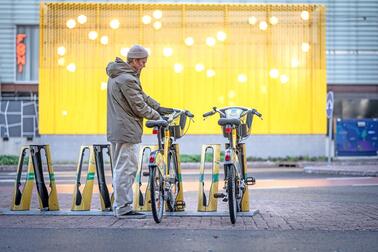
A key part of a continous Baana network
Mariantunneli is a significant part of the Baana network consisting of the main bicycle traffic connections. It will connect the original Baana, which was built in a railway shaft, to the planned Länsibaana running towards Lauttasaari and Espoo. The tunnel will provide clear, safe and continuous routes for east-west bicycle traffic and improve connections to other Baana routes in South Helsinki.
The tunnel, which is about 200 metres long, is also intended for pedestrians. Passage from the Lapinlahti area will become smoother, as cyclists and pedestrians can avoid crossing the busy Mechelininkatu street and waiting at traffic lights. On average, about 36,000 vehicles pass through Mechelininkatu at Lapinlahdenkatu on an autumn weekday. Ambulances have also been taken into account in the planning so they can drive into the tunnel, if necessary.

In addition to ceiling lights, the tunnel has been designed with booster lighting, the purpose of which is to increase the sense of safety. The colour of the wall-mounted lighting can be changed remotely according to the seasons or holidays, for example. The visual look will be refined in further planning.
The implementation of the traffic arrangements in accordance with the general plan will cost a total of approximately EUR 19 million.
Bicycle street proposed for Lapinlahdentie
The tunnel starts from the original Baana between Kamppi and Ruoholahti at Lapinlahdentie. It rises to the ground on Lapinlahdentie at the southern edge of the street.
In the plan, a bicycle street is proposed for Lapinlahdentie, where the driving speed must be adapted to the pace of bicycle traffic. Lapinlahdentie will have 24 parking spaces and four parking spaces for pick-up and drop-off traffic. In the current state, there is parking space for about 40 cars at the northern edge of the street and about 30 cars on the southern edge.
The culturally and historically valuable environment has been taken into account in the planning. The stone wall of the Orthodox cemetery built in the 19th century must be demolished for the duration of the construction work, but it will be documented and restored after the construction of the tunnel.
Traffic plan to be discussed by the Urban Environment Committee in January
A change in the local detailed plan for the former Maria Hospital area became valid in January 2023. In the change, a preliminary survey was carried out of the tunnel, and its indicative location was presented. At that time, the Urban Environment Committee decided that the implementation of the tunnel will be prepared for in the city’s 10-year investment programme at the end of the 2020s.
The tunnel’s traffic plan will be discussed by the Urban Environment Committee in January 2025. The general plan will be decided by the City Council. More detailed street and construction planning will begin once the City Council has approved the general plan.


